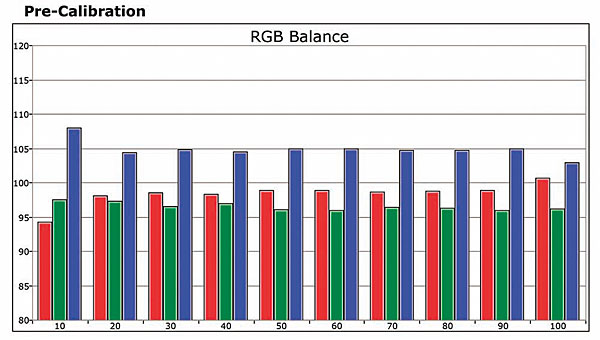BenQ HT4050 3D DLP Projector Review Test Bench
Fulll-On/Full-Off Contrast Ratio: 1,358:1
Calibrated peak white light output: 27.7 ft-L. Calibrated black level: 0.0204 ft-L
Measurements were made with a Quantum Data 780 generator, Minolta CS-200 color meter, and SpectraCal CalMAN 4 software.
Pre-calibration measurements were taken in the Cinema (Rec. 709) mode, which defaults to the Normal color temperature. Post-calibration was in the same mode, with Warm as the selected color temperature. Lamp mode was Smart Eco. The machine does not have an adjustable iris. The screen was an 87-inch-wide Stewart StudioTek 130 G3 (1.78:1 aspect ratio), though the HT4050 produces more than adequate light output for larger screens (above 96 inches wide).


Pre-calibration, but with Contrast properly adjusted for peak white, the HT4050 put out 48.33 ft-L of light. I throttled it back to 20.6 using Smart Eco lamp power mode with Brilliant Color off, which gave me the best black level when viewing content. The image was exceptionally vibrant yet 6 ft-L above SMPTE specification of 14 ft-L. As the lamp continues aging, at half life (800 to 1,000 hours), it should handily retain 14 ft-L output while maintaining crisp, appealing image fidelity. With Brilliant Color enabled in Smart Eco, the light output jumped up to 25.2 ft-L.
Expecting a substantial increase with lamp mode set to Normal, I was surprised to find the Delta negligible. With Brilliant Color set to Off, light output at 100 IRE peak white measured 20.6 ft-L—essentially the same as with Smart Eco. With Brilliant Color enabled, it measured 25.21 ft-L. Brilliant Color is designed to boost color midtones—which it observationally does with normal content—but did not seem to boost gray scale by 50 percent, which is said to be the measured increase.
Post-calibration, in the Cinema (Rec. 709) preset with the Smart Eco lamp mode, Brilliant Color set to Off, Contrast set to 34 and Brightness to 54, the measured contrast ratio using the full-on/full-off method was 1,358:1. At 100 percent white (full raster), peak white measured 27.7 ft-L, and the reading for 0 percent black was 0.0204 ft-L.
Using a 16-pane checkerboard pattern (intra-frame contrast), the ANSI contrast ratio was 43.2:1 The screen middle upper left white panel was 25.6 with the lower right panel at 25.4. The left middle lower black panel measured 0.4976, while the upper right black panel was 0.6841. Overall black level was more than acceptable, but not exceptional.

Prior to calibration, the BenQ’s Cinema (Rec. 709) color temperature preset exhibited a plus blue bias for all IRE levels. The pre-cal grayscale Delta E averaged 7.2; calibration greatly improvied upon that, delivering average Delta E of 1.08 (Delta E is a figure of merit that indicates how closely a display adheres to the Rec. 709 HD color standard. Experts generally agree that levels below 3 are visibly indistinguishable from perfect color tracking.) The largest deviations occurred at the extreme ends of the grayscale, with 10 IRE exhibiting a variance of 3.6 (where light output is lowest), at 30 IRE where a spike tilted the average up to 2.9, and at 100 IRE where red peaked a bit high.
Pre-calibration gamma and post-calibration gamma both nearly hit the target of 2.4. Gamma tracking was excellent, and aside from the review conclusion that black level was good but not excellent, details in shadows and highlights often lost in darker scenes were present and rendered appropriately.—MPH





























































